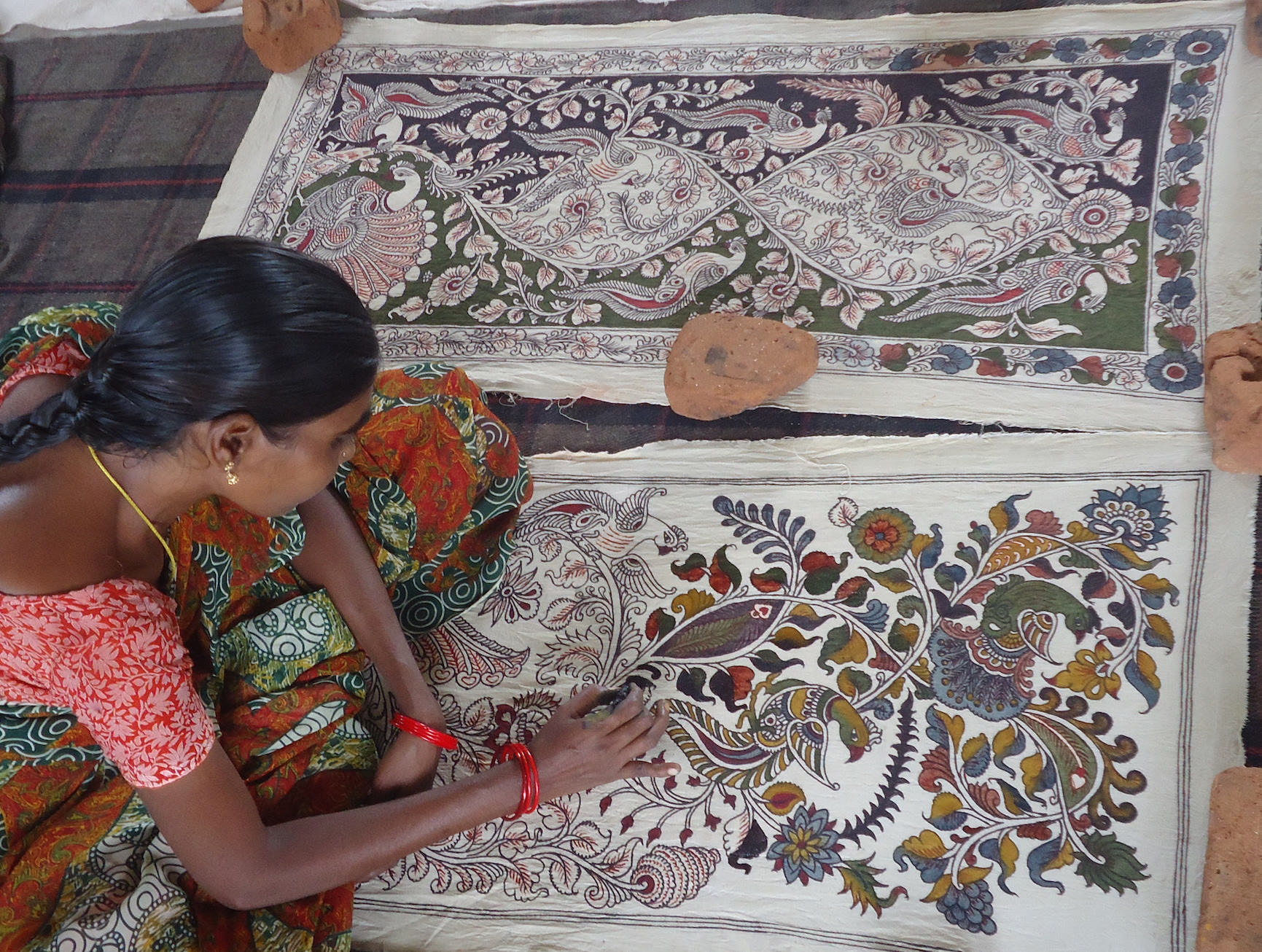In the realm of textile artistry, where every thread tells a story and every motif carries a meaning, Kalamkari stands as a testament to the exquisite craftsmanship and rich heritage of Indian art. This blog post is your gateway to the world of Kalamkari, an art form that has captured hearts worldwide with its intricate designs, vibrant colors, and the magic of hand-drawn patterns.

What Is Kalamkari?
Kalamkari, which translates to “pen work” in Persian, is a traditional Indian art form that involves hand-painting or block-printing intricate designs on fabric using natural dyes. It is renowned for its distinctive style, which combines both freehand and block-printing techniques. Kalamkari traces its origins to ancient India and has been practiced for over 3000 years.
Also see: The Timeless Artistry of Worli Painting: A Journey Through India’s Heritage
The Two Styles of Kalamkari
Kalamkari art is primarily categorized into two styles:
1. Srikalahasti Style:
Srikalahasti, a town in Andhra Pradesh, is renowned for its Kalamkari tradition. In this style, artists use a pen-like instrument, traditionally made from bamboo and date palm, to draw intricate motifs and designs on fabric. The detailing and precision in Srikalahasti Kalamkari are awe-inspiring.
2. Machilipatnam Style:
The Machilipatnam style, also known as the Pedana style, originates from the coastal town of Machilipatnam in Andhra Pradesh. Here, block-printing plays a significant role. Wooden blocks with carved designs are dipped in natural dyes and pressed onto the fabric. The result is a harmonious blend of hand-painted and block-printed patterns.
The Beauty of Natural Dyes
One of the distinctive features of Kalamkari is its use of natural dyes. Artists extract colors from various natural sources, such as roots, leaves, flowers, and minerals. This eco-friendly approach not only produces vibrant and long-lasting hues but also aligns with sustainable practices.
Themes and Motifs
Kalamkari designs are deeply rooted in Indian culture and mythology. You’ll find a plethora of motifs and themes, each with its unique symbolism. Some common motifs include:
- Floral Patterns: Depicting various flowers like lotus, jasmine, and marigold, symbolizing purity and beauty.
- Krishna Leela: Illustrating scenes from the life of Lord Krishna, a beloved figure in Indian mythology.
- Epic Tales: Narrating stories from the Ramayana and Mahabharata through intricate patterns.
- Animal Motifs: Featuring animals like elephants and peacocks, which hold cultural significance.
The Process of Creating Kalamkari
Creating Kalamkari is a labor-intensive and time-consuming process. Here’s a simplified overview of the steps involved:
- Preparing the Fabric: The fabric, usually cotton or silk, is treated to remove impurities and provide a smooth surface for painting.
- Outlining the Design: In Srikalahasti style, artists use a fine-tipped pen to meticulously outline the design. In the Machilipatnam style, the block-printed outline is applied.
- Filling in Colors: Natural dyes are carefully filled within the outlined patterns, with different blocks or pens used for various colors.
- Sun Drying: After coloring, the fabric is left in the sun to dry, allowing the colors to set.
- Washing and Finishing: The fabric undergoes a final wash to remove excess dye, and it is then ready for use.
The Enduring Legacy of Kalamkari
Kalamkari, with its timeless appeal and rich cultural heritage, continues to be a cherished art form. Its influence extends beyond textiles, with Kalamkari designs adorning a wide range of products, from clothing and home decor to accessories and artwork.
In Conclusion
Kalamkari is not merely an art form; it’s a glimpse into India’s rich history, its cultural diversity, and the skilled hands that bring life to fabric. Whether you admire it for its aesthetic beauty or connect with it on a deeper cultural level, Kalamkari is a testament to the enduring legacy of traditional Indian artistry. It’s a celebration of craftsmanship, creativity, and the age-old tradition of handcrafted excellence that continues to inspire and captivate the world.

